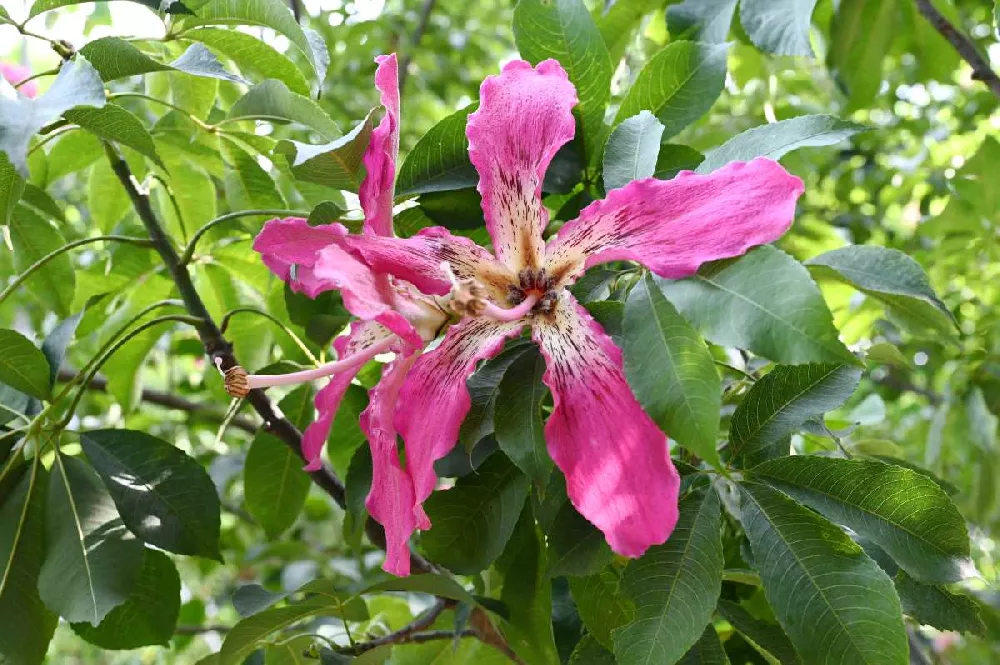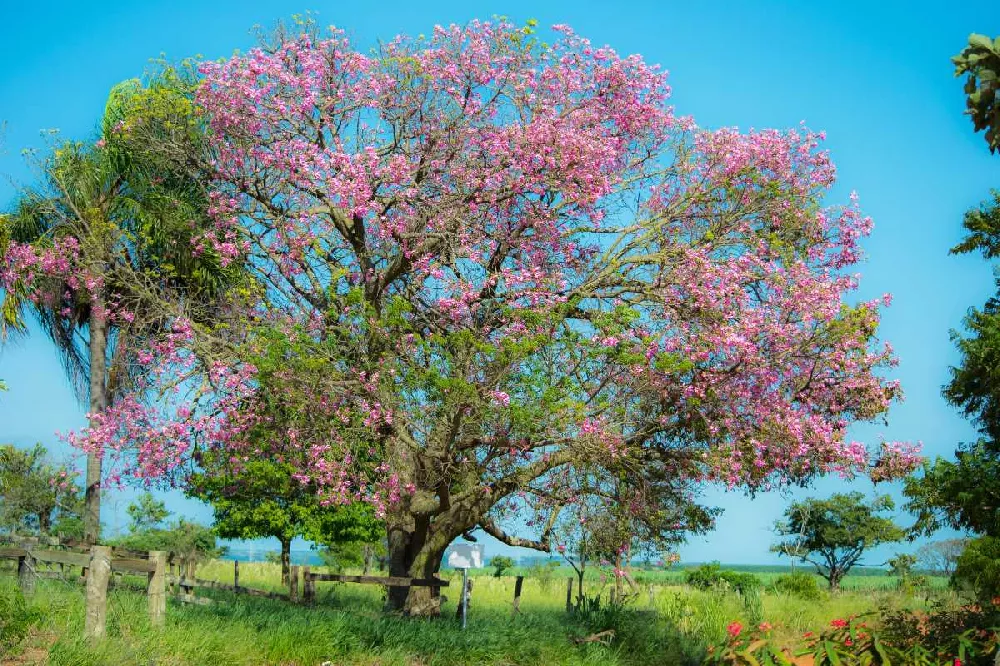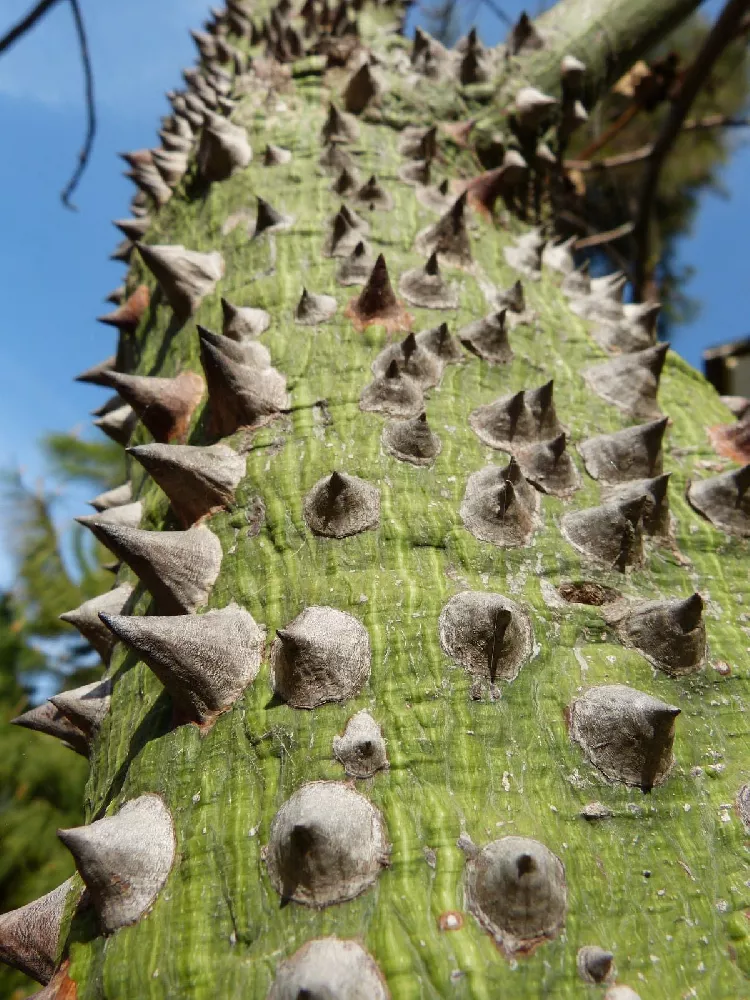Pink Silk Floss Tree for Sale - Buying & Growing Guide
Native to South America, the Pink Silk Floss Tree, Ceiba speciosa, is a large, handsome tree that holds its own in most landscape settings. It has a dense, umbrella-like canopy that makes it an excellent shade tree. In the fall, it is covered with vivid, bright purple-pink flowers that resemble small hibiscus flowers—which is not surprising because it is related to the hibiscus. Pollinated flowers lead to green, avocado-like seed pouches which are filled with a gossamer, silky substance—giving the tree its name. These silky filaments are used in the developing world to stuff pillows and jackets. In winter, the tree's leaves drop, but there is still interest in the bark, which is green when young and mellows to gray, and it is densely covered with dull thorns. Here are a few more reasons to consider the Pink Silk Floss Tree for your garden:
- It is a fast grower when young; growth slows when the tree reaches about 30 feet.
- Its flowers are attractive to pollinating insects as well as to hummingbirds.
- It blooms in late fall when there is little other interest in the garden.
Enter your zip code to find nearby stores that may carry this plant.
Plant Care
Sunlight

The Pink Silk Floss Tree grows best in full sun—at least six hours of direct sunlight a day.
Watering
Once established, these trees are drought-resistant; water young plants weekly during warm weather.
Fertilizing

Fertilize with a slow-release balanced product designed for tropical trees and shrubs.
Planting and Care
Planting instructions
Site your tree where it will get at least six hours of sunlight a day and be in soil that drains well. Note that a mature Pink Silk Floss Tree can have a height and width of 40 feet or more; so, don’t plant it under overhead utility wires or too close to buildings. Unpot your sapling and tease out any encircling roots, which can girdle the tree and slowly kill it. Dig a hole that’s as deep as the root ball and twice as wide. Place the tree in the hole and spread out the roots. While holding it upright and steady, fill in around it with topsoil and tamp down as you go to eliminate air pockets. Water thoroughly. Apply a two to three-inch layer of organic mulch such as bark chips around the root zone but keep it from touching the trunk to avoid rot.
Watering and nutrients
For its first few years, water your tree regularly while it’s developing a robust root system. To check if it needs water, look at the soil two inches below the surface—if it’s dry, give your tree a drink. A mature tree will only need supplemental watering in very hot or dry weather, as it is somewhat drought resistant. Fertilize a young tree with a balanced product designed for tropical trees. Once it’s mature, your tree won’t need supplemental feeding.
Pollination
The Pink Silk Floss Tree is pollinated by insects and birds, especially hummingbirds, who are drawn to the showy flowers. Pollinated flowers develop oval fruit pods that, when opened, contain black seeds surrounded by a fluffy, fibrous material. Trees that are grown at the northern end of their range may not set seeds.
Pruning
The Pink Silk Floss Tree needs little regular pruning. Monitor the tree for dead, diseased or damaged limbs and trim them out whenever you see them. The tree should naturally assume a pleasing, rounded canopy, but low branches or suckers can be pruned out when it is young to shape it.
Pests and diseases
There are no major pests or diseases that are common to the Pink Silk Floss trees. You may see insects such as aphids or scale insects, but a healthy tree should not have any problems fending them off. Infrequently, leaf spot diseases may appear, which are usually caused by fungal growth and wet weather. Although they may disfigure leaves, they do not pose a serious threat to the tree unless they are present for several years. If there is a persistent problem with leaf spot, consult a horticulturist.
Achieving maximum results
Knowing how to use this magnificent tree in your landscape is the first step toward achieving maximum results. The Pink Silk Floss Tree is not a shy, retiring tree and will take up much space and interest in any garden it’s in. If you have a small garden, you might be better served with a flowering tree that tops out at 15 to 20 feet, such as a crabapple. In a larger yard, however, the Silk Floss Tree can make a superb specimen when planted in a prominent spot in a front yard. It is frequently seen as a street planting in some regions and can make an excellent backdrop to smaller flowering trees or perennial shrubs. In a backyard, plant it in a corner to serve as an anchor for other plantings.
FAQs
How big will the Pink Silk Floss Tree get?
A mature silk floss tree may reach a height of as much as 60 feet, although it is more likely to top out at around 40 feet. Interestingly, it has a variable growing rate: quite fast when young, and then slower after the first decade or so. The mature width of the Pink Silk Floss Tree is 20 to 40 feet; so, keep that in mind when choosing a planting site.
Where does Pink Silk Floss Tree grow best?
As a tropical tree, it grows best in the most southern areas of the U.S. It is popular in Florida and parts of Texas and Louisiana. It is also frequently seen in the coastal areas of California and is quite common in southern cities such as San Diego. In general, it will grow anywhere where the temperature doesn’t drop below 30 degrees Fahrenheit.
Is the Pink Silk Floss Tree deciduous?
Yes. Although it may seem surprising for a tropical tree, the Pink Silk Floss tree drops its leaves in winter. It may, in fact, flower after the leaves have dropped since flowering occurs in October and November. This does not mean that there is no winter interest, however, since the seed pods persist through the spring, and the tree's trunk, with its horn-like thorns, makes an attractive silhouette in the winter garden.
You can't add more Product Name - Product size to the cart.
OK



